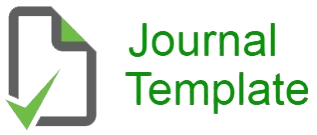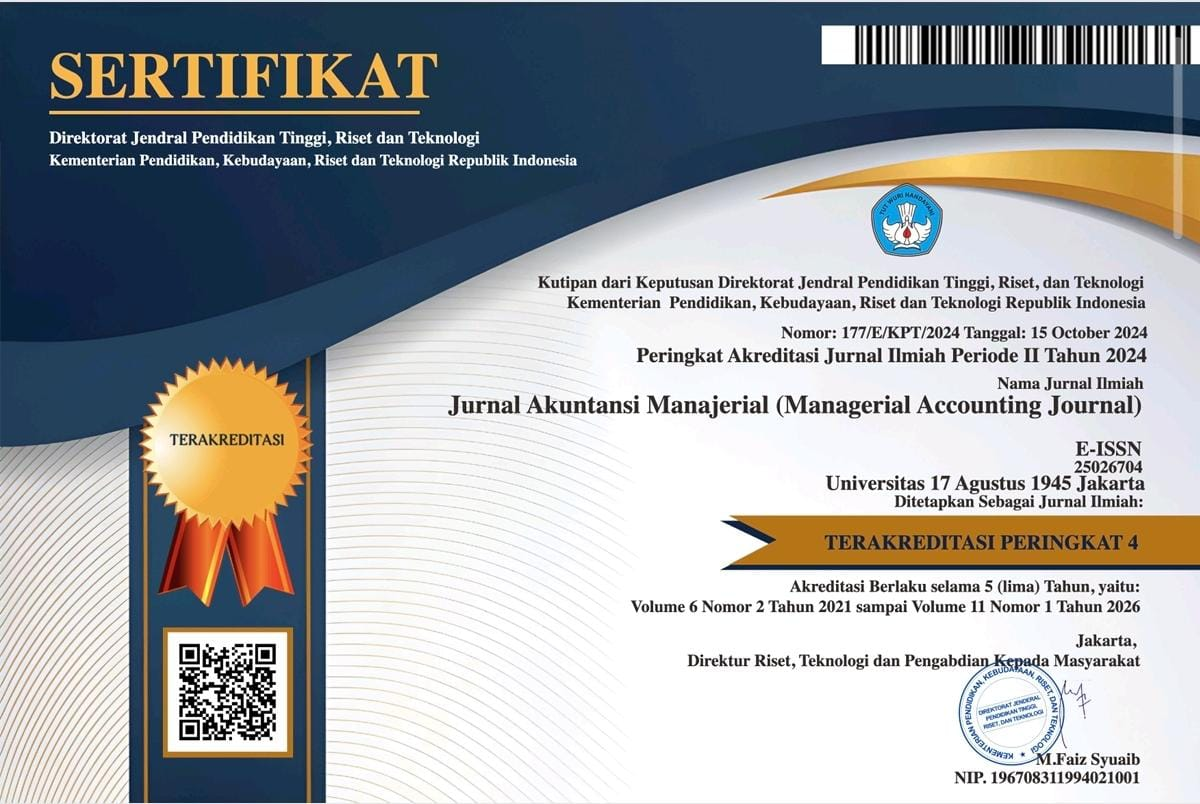PENGARUH FAKTOR-FAKTOR DALAM TEORI FRAUD HEXAGON TERHADAP KECURANGAN LAPORAN KEUANGAN
Abstract
Penelitian ini bertujuan untuk menguji faktor-faktor yang berpengaruh terhadap terjadinya kecurangan laporan keuangan yang disebut dengan fraud hexagon sebelum dan selama masa pandemi Covid-19. Penelitian ini menggunakan data laporan keuangan kuartalan perusahaan farmasi yang terdaftar di Bursa Efek Indonesia tahun 2018-2021. Penelitian ini menerapkan teknik purposive sampling. Hasil penelitian ini membuktikan bahwa opportunity dan rationalization berpengaruh terhadap terjadinya fraudulent financial reporting. Sementara itu, stimulus, capability, collusion, dan ego tidak berpengaruh terhadap terjadinya fraudulent financial reporting. Berdasarkan uji beda, secara empiris terbukti bahwa fraudulent financial reporting menurun pada periode selama pandemi Covid-19 dibandingkan dengan periode sebelum terjadinya pandemi Covid-19.
Keywords
Full Text:
PDF (Bahasa Indonesia)References
Achmad, T., Ghozali, I., & Pamungkas, I. D. (2022). Hexagon Fraud : Detection of Fraudulent Financial Reporting in. Economies, 10(13), 1–16. https://doi.org/10.3390/%0Aeconomies10010013
AICPA. (2002). SAS No. 99. “AU Section 316 Consideration of Fraud in a Financial Statement Audit”.AICPA. New York.
Association of Certified Fraud Examiners. (2020). Report to the Nations on Occupational Fraud and Abuse: 2020 Global Fraud Study. Association of Certified Fraud Examiners, Inc., 1–88. https://www.acfe.com/report-to-the-nations/2020/
Association of Certified Fraud Examiners. (2022). Occupational Fraud 2022: A Report to the Nations. https://www.acfe.com/
Beneish, Messod D. (1999). The Detection of Earnings Manipulation. Financial Analysis
Journal, 55 (5), https://doi.org/24-36.10.2469/faj.v55.n5.2296.
Boyle, D. M., DeZoort, F. T., & R., D. H. (2015). The effect of alternative fraud model use on auditors’ fraud risk judgments. Journal of Accounting and Public Policy, 34(6), 578–596.
Chantia, D., Guritno, Y., & Sari, R. (2021). Detection of Fraudulent Financial Statements : Fraud Hexagon S.C.C.O.R.E Model Approach. Business Management, Economic, and Accounting National Seminar, 2(3), 594–613.
Cressey, D. R. (1964). Delinquency, Crime And Differential Association. Springer.
Crowe, Horwath. (2012). The mind behind the fraudsters crime: key behavioral and environmental elements. In Crowe Horwath LLP.
Eisenhardt, K. M. (1989). Agency Theory: An Assessment and Review. The Academy of Management Review, 14(1), 57–74. https://doi.org/https://doi.org/10.2307/258191
Habib, A., Muhammadi, A. H., & Jiang, H. (2017). Political connections, related party transactions, and auditor choice: Evidence from Indonesia. Journal of Contemporary Accounting and Economics, 13(1), 1–19.
Hambrick, D. C., Misangyi, V. F., & Park., C. A. (2015). The Quad Model for Identifying a Corporate Director’s Potential for Effective Monitoring: Toward a New Theory of Board Sufficiency. The Academy of Management Review, 40(3), 323–344.
Imtikhani, L., & Sukirman, S. (2021). Determinan Fraudulent Financial Statement Melalui Perspektif Fraud Hexagon Theory Pada Perusahaan Pertambangan. Jurnal Akuntansi Bisnis, 19(1), 96. https://doi.org/10.24167/jab.v19i1.3654
Isnawati, Inapty, B. A., & Effendy, L. (2022). Deteksi Kecurangan Laporan Keuangan Di Masa Pandemi Covid-19 Dengan Model Beneish M-Score Dan Model F-Score. Jurnal Riset Akuntansi Aksioma, 22(2), 155–169. https://doi.org/10.29303/aksioma.v21i2.165
Jensen, M. C., & Meckling, W. H. (1976). Theory of The Firm: Managerial Behavior, Agency Costs and Ownership Structure. Journal of Financial Economics, 3, 305–360.
Khamainy, A. H., Amalia, M. M., Cakranegara, P. A., & Indrawati, A. (2022). Financial Statement Fraud: The Predictive Relevance of Fraud Hexagon Theory. Journal of Accounting and Strategic Finance, 5(1), 110–133. https://doi.org/10.33005/jasf.v5i1.249
Larum, K., Zuhroh, D., & Subiyantoro, E. (2021). Fraudlent Financial Reporting: Menguji Potensi Kecurangan Pelaporan Keuangan dengan Menggunakan Teori Fraud Hexagon. AFRE Accounting and Financial Review, 4(1), : 82-94. https://doi.org/https://doi.org/10.26905/afr.v4i1.5957.
Lastanti, H. S., Murwaningsari, E., & Umar, H. (2022). the Effect of Hexagon Fraud on Fraud Financial Statements With Governance and Culture As Moderating Variables. Media Riset Akuntansi, Auditing & Informasi, 22(1), 143–156. https://doi.org/10.25105/mraai.v22i1.13533
Novarina, D., & Triyanto, D. N. (2022). Pengaruh Fraud Hexagon Terhadap Kecurangan Laporan Keuangan Pada Perusahaan LQ 45 Yang Terdaftar di Bursa Efek Indonesia Periode 2016-2020. Jurnal Akuntansi Dan Keuangan, 10(2), 183. https://doi.org/10.29103/jak.v10i2.7352
Nugroho, D. S., & Diyanty, V. (2022). Hexagon Fraud In Fraudulent Financial Statements : Jurnal Akuntansi Dan Keuangan Indonesia, 19(1), 46–67. https://doi.org/10.21002/jaki.2022.03.
Prayoga, M. & Purwanti, D. (2020). Case Analysis Of Revenue Recognition Fraud Of Pt Garuda Indonesia (Persero) Tbk In 2018. Riset: Jurnal Aplikasi Ekonomi Akuntansi dan Bisnis. 2, 2 (Sep. 2020), 289 - 306. DOI:https://doi.org/10.35212/riset.v2i2.63.
Putra, D. G. (2021). Pendekatan Remote Auditing Untuk Internal Audit Dalam Mendeteksi Kecurangan (Fraud) Pada Masa Pandemi Covid-19. Jurnal Ecogen, 4(1), 1. https://doi.org/10.24036/jmpe.v4i1.10575
Ramadhan, D. (2020). Root Cause Analysis Using Fraud Pentagon Theory Approach (a Conceptual Framework). Asia Pacific Fraud Journal, 5(1), 118. https://doi.org/10.21532/apfjournal.v5i1.142
Sari, S. P., & Nugroho, N. K. (2020). Financial Statements Fraud dengan Pendekatan Vousinas Fraud Hexagon Model: Tinjauan pada Perusahaan Terbuka di Indonesia 26. 1st Annual Conference of Ihtifaz: Islamic Economics, Finance, and Banking, 409–430.
Tarjo, & Herawati, N. (2015). Application of Beneish M-Score Models and Data Mining to Detect Financial Fraud. Procedia - Social and Behavioral Sciences, 211, 924–930. https://doi.org/10.1016/j.sbspro.2015.11.122
Tarmizi, A., & Didin H. P. (2022). Pengaruh Kepemilikan Institusional, Kepemilikan Keluarga, Dan Thin Capitalization Terhadap Penghindaran Pajak. Jurnal Perspektif Manajerial dan Kewirausahaan, 3, (1), 47 – 61. http://jurnal.undira.ac.id/index.php/jpmk/.
Ulfah, M., Nuraina, E., & Wijaya, A. L. (2017). Pengaruh Fraud Pentagon Dalam Mendeteksi Fraudulent Financial Reporting (Studi Empiris Pada Perbankan Di Indonesia Yang Terdaftar Di Bei. Forum Ilmiah Pendidikan Akuntansi, 5(1), 399–418. Fraud, Fraud Pentagon, Fraudulent Financial Reporting
Umar, H., Partahi, D., & Purba, R. (2020). Fraud Diamond Analysis in Detecting Fraudulent Financial Report. Internal Journal of Sciencetific & Technology Research, 9 (3), 6638-6646. https://www.researchgate.net/publication/340617082.
Vousinas, G. L. (2019). Advancing theory of fraud: The S.C.O.R.E. Model. Journal of Financial Crime, 26(1), 372–381.
Wardhani, W. K., Titisari, K. H., & Suhendro, S. (2021). Pengaruh Profitabilitas, Struktur Modal, Ukuran Perusahaan, Dan Good Corporate Governance terhadap Nilai Perusahaan. Ekonomis: Journal of Economics and Business, 5(1), 37. https://doi.org/10.33087/ekonomis.v5i1.264
Wicaksono, A., & Suryandari, D. (2021). The Analysis of Fraudulent Financial Reports Through Fraud Hexagon on Public Mining Companies. Accounting Analysis Journal, 10(3), 220–228. https://doi.org/10.15294/aaj.v10i3.54999
Wolfe, B. D. T., & D. R. Hermanson, D. R. (2004). The Fraud Diamond: Considering the Four Elements of Fraud. The CPA Journal, 74 (12), 38-42.
https://digitalcommons.kennesaw.edu/facpubs/1537/.
Zaki, N. M. (2017). The Appropriateness Of Fraud Triangle and Diamond Models In Assessing The Likelihood Of Fraudulent Financial Statements- An Empirical Study On Firms Listed In The Egyptian Stock Exchange. International Journal of Social Science & Economic Research, 02, 2403–2433.
DOI: https://doi.org/10.52447/jam.v9i1.7584
Refbacks
- There are currently no refbacks.







